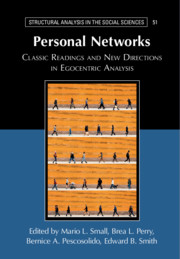Book contents
- Personal Networks
- Structural Analysis in the Social Sciences
- Personal Networks
- Copyright page
- Contents
- Figures
- Tables
- Contributors
- I Background
- II Early Foundations
- 1 From Georg Simmel, “On the Significance of Numbers for Social Life: Introduction,” “The Isolated Individual and the Dyad,” “The Triad,” and “The Web of Group Affiliations”
- Georg Simmel’s Contribution to Social Network Research
- 2 From Elihu Katz and Paul F. Lazarsfeld, Personal Influence
- Influencers, Backfire Effects, and the Power of the Periphery
- 3 From J. Clyde Mitchell, “The Concept and Use of Social Networks”
- On J. Clyde Mitchell’s “The Concept and Use of Social Networks”
- 4 From Elizabeth Bott, “Urban Families: Conjugal Roles and Social Networks”
- Commentary on Bott’s “Family and Social Network”
- 5 From Leon Festinger, Stanley Schachter, and Kurt Back, Social Pressures in Informal Groups
- Festinger, Schachter, and Back’s Social Pressures in Informal Groups
- 6 From H. Russell Bernard, Peter Killworth, David Kronenfeld, and Lee Sailer, “The Problem of Informant Accuracy”
- Implications of Informant Accuracy Research for Ego Networks
- 7 From Harrison C. White, Identity and Control
- On Parachutes and Lion-Taming
- III Later Foundations
- IV New Perspectives
- Index
- Recent Books in the Series
- References
Influencers, Backfire Effects, and the Power of the Periphery
from II - Early Foundations
Published online by Cambridge University Press: 01 October 2021
- Personal Networks
- Structural Analysis in the Social Sciences
- Personal Networks
- Copyright page
- Contents
- Figures
- Tables
- Contributors
- I Background
- II Early Foundations
- 1 From Georg Simmel, “On the Significance of Numbers for Social Life: Introduction,” “The Isolated Individual and the Dyad,” “The Triad,” and “The Web of Group Affiliations”
- Georg Simmel’s Contribution to Social Network Research
- 2 From Elihu Katz and Paul F. Lazarsfeld, Personal Influence
- Influencers, Backfire Effects, and the Power of the Periphery
- 3 From J. Clyde Mitchell, “The Concept and Use of Social Networks”
- On J. Clyde Mitchell’s “The Concept and Use of Social Networks”
- 4 From Elizabeth Bott, “Urban Families: Conjugal Roles and Social Networks”
- Commentary on Bott’s “Family and Social Network”
- 5 From Leon Festinger, Stanley Schachter, and Kurt Back, Social Pressures in Informal Groups
- Festinger, Schachter, and Back’s Social Pressures in Informal Groups
- 6 From H. Russell Bernard, Peter Killworth, David Kronenfeld, and Lee Sailer, “The Problem of Informant Accuracy”
- Implications of Informant Accuracy Research for Ego Networks
- 7 From Harrison C. White, Identity and Control
- On Parachutes and Lion-Taming
- III Later Foundations
- IV New Perspectives
- Index
- Recent Books in the Series
- References
Summary
How are people convinced to change their minds? What makes them switch to a new political candidate, decide to join a contentious social movement, or become willing to vote in an upcoming election?
- Type
- Chapter
- Information
- Personal NetworksClassic Readings and New Directions in Egocentric Analysis, pp. 73 - 86Publisher: Cambridge University PressPrint publication year: 2021
References
- 6
- Cited by



